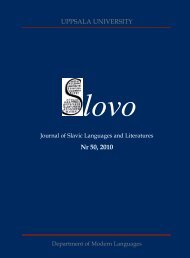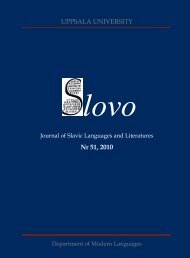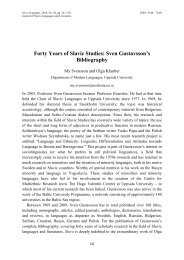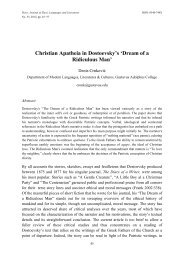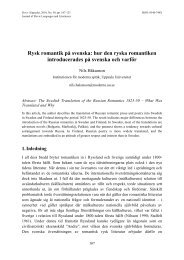Full text PDF - Index of - Uppsala universitet
Full text PDF - Index of - Uppsala universitet
Full text PDF - Index of - Uppsala universitet
Create successful ePaper yourself
Turn your PDF publications into a flip-book with our unique Google optimized e-Paper software.
Atle Grønn<br />
‘Byvalo’ and ‘used to’ as verbal quantifiers<br />
any inherent morphological feature and therefore simply transmits the tense feature<br />
from the finite verb, the future quantifier “will”, which carries present tense<br />
morphology. The result is that the subordinate verb “appears” (“erscheint”) derives its<br />
present morphology from “will” through “be an occasion”. In the theory proposed<br />
here, “appears” and “erscheint” are in the semantic binding domain <strong>of</strong> “be an<br />
occasion” and “vorkommen”, respectively, – the former in an adjunct and the latter in<br />
a complement. We observe feature transmission under semantic binding. In this way<br />
both the future reference time and the present morphology originating with “will”<br />
(“wird”) are carried over to the subordinate verbs.<br />
3. ‘Used to’ and the SOT parameter<br />
If tense morphology under byvalo (or byvaet) is ultimately to be explained in the light<br />
<strong>of</strong> Russian being a non-SOT language, we should expect SOT rules to be relevant for<br />
tense morphology under used to in English.<br />
The main reason why these constructions in Germanic languages have not (to my<br />
knowledge) been analysed in the light <strong>of</strong> SOT rules is probably due to the simple fact<br />
that verbal quantifiers like “used to” subcategorize for an infinitive complement, i.e. a<br />
non-finite verb form without tense morphology. Hence, the issue <strong>of</strong> morphological<br />
tense agreement between the matrix and complement does not arise.<br />
However, once the SOT parameter is extended to capture tense agreement<br />
phenomena in adjunct tenses, we can at least try to falsify the hypothesis that “used to”<br />
is subject to the SOT parameter. In the English example below, we do indeed find the<br />
expected tense agreement in the relative clause: “used to … take … whom she<br />
considered”.<br />
(10) Преосвященный слушал свою мать и вспоминал, как когда-то, многомного<br />
лет назад, она возила и его, и братьев, и сестер к родственникам,<br />
которых считала богатыми. (Anton Čechov, “Archierej”)<br />
(11) The bishop listened to his mother and remembered how many, many years ago<br />
she used[up] to take him and his brothers and sisters to relations whom she<br />
considered[up] rich.<br />
While verbs in complements under temporal quantifiers are semantically tenseless<br />
(bound), the highest tense in adjuncts is anaphoric to the matrix reference time (Grønn<br />
& von Stechow 2011). On this view “considered” gets its interpretation from the<br />
reference time <strong>of</strong> “take” and its morphology from “used to” (feature transmission<br />
under semantic binding via the non-finite “take”). Thus, our initial hypothesis lives on,<br />
cf. Figure 3.<br />
67



